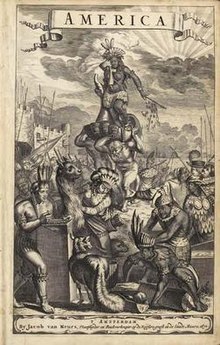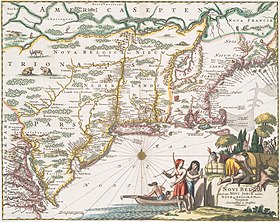De Nieuwe en Onbekende Weereld
 Cover of the first edition | |
| Author | Arnoldus Montanus |
|---|---|
| Language | Dutch |
| Genre | Travel literature, scientific |
| Publisher | Jacob van Meurs |
Publication date | 1671 |
| Publication place | Netherlands |
| Media type | |
| Pages | 585 pp |
| Preceded by | Gedenkwaerdige Gesantschappen der Oost-Indische Maetschappy in't Vereenigde Nederland |
| Followed by | Ambassades mémorables de la Compagnie |
De Nieuwe en Onbekende Weereld (Dutch) or The New and Unknown World (English) is a book by Arnoldus Montanus. It was published by Jacob van Meurs. It was published, after translation into English, by John Ogilby. The book has 125 engravings made of copper. It has 70 plates and 16 maps.[1]
Full title
Dutch
The full title of the work in Dutch is De Nieuwe en Onbekende Weereld: of Beschryving van America en 't Zuid-Land, Vervaetende d'Oorsprong der Americaenen en Zuid-landers, gedenkwaerdige togten derwaerds, Gelegendheid Der vaste Kusten, Eilanden, Steden, Sterkten, Dorpen, Tempels, Bergen, Fonteinen, Stroomen, Huisen, de natuur van Beesten, Boomen, Planten en vreemde Gewasschen, Gods dienst en Zeden, Wonderlijke Voorvallen, Vereeuwde en Nieuwe Oorlogen: Verciert met Af-beeldsels na 't leven in America gemaekt, en beschreeven door Arnoldus Montanus'[2]
English
The full title of the work in English is The New and Unknown World: or Description of America and the Southland, Containing the Origin of the Americans and South-landers, remarkable voyages thither, Quality of the Shores, Islands, Cities, Fortresses, Towns, Temples, Mountains, Sources, Rivers, Houses, the nature of Beasts, Trees, Plants and foreign Crops, Religion and Manners, Miraculous Occurrences, Old and New Wars: Adorned with Illustrations drawn from the life in America, and described by Arnoldus Montanus.
Reception
"Montanus never visited the New World and his work contains numerous errors and fantastic conceptions about the people and animals of the Americas. Nonetheless, it became a standard work in Europe and was widely read for many years."[1]
Gallery
- Novi Belgii, quod nunc Novi Jorck vocatur, Novæque Angliæ & partis Virginiæ Accuratissima et Novissima Delineatio, 1671
References
- ^ a b "The New and Unknown World: or Description of America and the Southland". World Digital Library. 1671. Retrieved 2013-07-02.
- ^ Facsimile of original 1671 manuscript
Further reading
- Arnoldus Montanus (1671). "De Nieuwe en onbekende weereld: of Beschryving van America en't zuid-land" [The New and Unknown World: or Description of America and the Southland] (in Dutch). Antwerp: J. Meurs. (Index)

